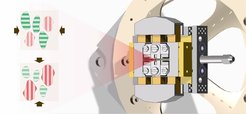Uniaxial strain control of charge density waves in cuprates
Despite considerable research effort over several decades, the mechanism of high-Tc superconductivity in cuprates remains unsettled. An approach to tackle this problem is to understand the normal state from which superconductivity arises. Charge density waves, i.e. spatially periodic modulations of the electronic charge density, are universally observed in the normal state of the cuprates. Resonant x-ray scattering is one of the best experimental techniques to study this phase, since RXS data represent the Fourier transform of the charge density in space, and the resonant scattering process is sensitive enough to detect even small charge modulations. In RXS experiments, CDWs appear as peaks in momentum space, whose position, width, and intensity indicate the periodicity, correlation length, and amplitude of the density modulation.

In this work, we applied uniaxial pressure along both a- and b-axes of YBa2Cu3O6.67 single crystals and used RXS to monitor the response of CDW in both directions. We found that the effect of uniaxial pressure on the electron correlations in the copper-oxide planes is highly anisotropic and enhances the CDW with modulation perpendicular to the strain direction. Thus, a-axis pressure enhances the b-CDW, whereas b-axis pressure does not affect it. Conversely, b-axis pressure only enhances the a-CDW. In addition, we observed that a pressure-induced CDW with three-dimensional long-range order appears at high strain along the b-axis. These results resolve some key questions in the debate about the nature of the CDW in the cuprates, including a definitive confirmation of its uniaxial character. They thus impose stringent constraints on the theoretical description of the CDW and its competition with high-Tc superconductivity.











